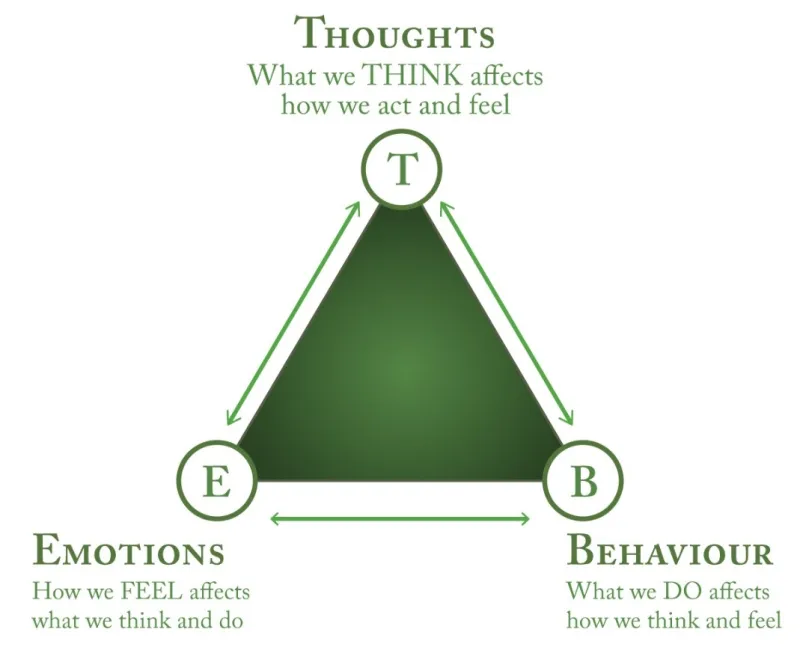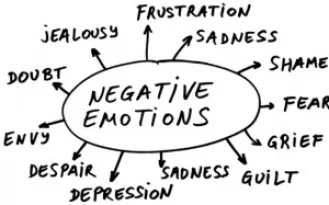If you’ve read any of my other posts on the Cognitive Behavioral Therapy Triangle, the first paragraph is the same. Feel free to skip down to after the diagram for new content or reread the initial paragraph as a refresher!
The Cognitive Behavioral Therapy Triangle tells us that our behavior, emotions, and thoughts are deeply intertwined. If one of these elements is out of whack, our whole lives can begin to spiral out of control. On the flipside of that, if we work to improve just one of these factors, there’s a high likelihood for the others to improve as well.

EMOTIONS: HOW WE FEEL AFFECTS WHAT WE THINK AND DO
Emotions are central to our experiences of the world. You might be really content after eating a bar of chocolate. Or you could be anxious while watching a sporting event. While we often think about how actions make us feel, how often do you think about how your feelings make you act or think? Happiness can make a mundane task more enjoyable, but sadness could make it difficult to do the activities that you usually enjoy. Anger might cause you to think negatively of a loved one. Regret can lead to never-ending thoughts on what you could have done differently. As we go through life, it’s important for us to be attuned to the relationship between our emotions, thoughts, and behaviors. The following steps outline ways in which we can manage negative emotions so that they don’t get the best of us.
MANAGING NEGATIVE EMOTIONS
1) RECOGNIZE THE EMOTION
When we feel “out of sorts” it might be because we haven’t allowed ourselves time and space to process the emotion we’re experiencing. Sadness, anger, and fear might be the negative emotions that most readily come to mind for you, but those are just a few. Below are some more examples of negative emotions you may have experienced.

To recognize emotions, it’s important to have a better understanding of the broad array of negative emotions that exist, because these emotions impact how we think about ourselves and others as well as how we act.
2) REACT TO THE EMOTION
I’d argue that our reactions to emotions are the most important part of managing negative emotions. The thoughts and actions that follow a negative emotion can derail us or help get us on the right track. I think of reactions to negative emotions in two buckets.
Mindful Reactions: According to Webster’s dictionary, mindfulness is “the practice of maintaining a nonjudgmental state of heightened or complete awareness of one’s thoughts, emotions, or experiences on a moment-to-moment basis.” In my own words, mindfulness helps us to be aware of how our emotions make us think and act. For example, I recently felt sad because of some unexpected news. I practiced mindfully reacting to my sad emotion by 1) recognizing my sadness 2) being kind enough with myself to know that my emotions were valid, and 3) chatting with friends and family to process my feelings. Mindful reactions to negative emotions encourage us to focus on positive thoughts in lieu of the negative emotion. As a result of positive thinking, we are at a reduced risk of performing self-harming behaviors.
Judgemental reactions: Judgmental reactions to negative emotions occur when we think negatively about the emotions that we experience. This self-criticism impacts our thoughts about ourselves. Though everyone has at some time or another experienced a judgmental reaction to negative emotions, I encourage you to try mindfulness as outlined above to become aware of the judgemental reaction and to then shift your focus to more positive thoughts.
3) CREATE A PLAN TO AVOID SELF-HARMING ACTIONS
“Failing to plan is planning to fail.”
At the Veterans Affairs Medical Center (VAMC) where I spent a month on the inpatient psychiatry unit, I had the privilege of completing safety plans with my patients. My patients were admitted to the unit for diagnoses ranging from psychosis and suicidal ideation to alcohol and opiate detox. During each safety plan session, I engaged my patients in conversations to help them 1) recognize their emotional and environmental triggers for self-harming behavior 2) create a list of alternative actions to self-harming behaviors, and 3) identify support systems to help them remain safe. As you think about emotions that might lead you to isolate, overly self-critique, or cause physical self-harm, I encourage you to use these same steps I used with my patients. As I mentioned in Cognitive Behavioral Therapy Triangle: Behaviors, having an accountability partner can help to make your plan come to life.
CONCLUSION
Emotions affect your thoughts and behaviors, whether positively or negatively. Hopefully, this post helped you to get a better understanding of how you can manage negative emotions to help guide your thoughts and actions. By recognizing and reacting to your emotions, then creating a plan to avoid self-harming behaviors, you can work toward finding a balance between your emotions, thoughts, and behaviors. If you’d like to learn more, check out my other posts below on behaviors and thoughts.
POST 1 – Intro to Cognitive Behavioral Therapy Triangle
POST 2 – Behavior: What we do affects how we feel and think
POST 3 – Thoughts: What we think affects how we act and feel
The above information is my analysis of an existing psychology theory and is not intended to diagnose or treat. Please reach out to medical professionals if you or a loved one is in need of care.
National Suicide Prevention Lifeline: 1-800-273-8255
UPenn Counseling and Psychological Services (CAPS): 1-215- 898-7021
Peace and blessings,
Atasha Jordan, MD (to be)
Featured image photo cred: master1305






